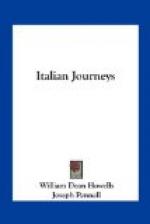All Parma is full of Correggio, as Venice is of Titian and Tintoretto, as Naples of Spagnoletto, as Mantua of Giulio Romano, as Vicenza of Palladio, as Bassano of Da Ponte, as Bologna of Guido Reni. I have elsewhere noticed how ineffaceably and exclusively the manner of the masters seems to have stamped itself upon the art of the cities where they severally wrought,—how at Parma Correggio yet lives in all the sketchy mouths of all the pictures painted there since his time. One might almost believe, hearing the Parmesans talk, that his manner had infected their dialect, and that they fashioned their lazy, incomplete utterance with the careless lips of his nymphs and angels. They almost entirely suppress the last syllable of every word, and not with a quick precision, as people do in Venice or Milan, but with an ineffable languor, as if language were not worth the effort of enunciation; while they rise and lapse several times in each sentence, and sink so sweetly and sadly away upon the closing vocable that the listener can scarcely repress his tears. In this melancholy rhythm, one of the citizens recounted to me the whole story of the assassination of the last Duke of Parma in 1850; and left me as softly moved as if I had been listening to a tale of hapless love. Yet it was an ugly story, and after the enchantment of the recital passed away, I perceived that when the Duke was killed justice was done on one of the maddest and wickedest tyrants that ever harassed an unhappy city.
The Parmesans remember Maria Louisa, Napoleon’s wife, with pleasant enough feelings, and she seems to have been good to them after the manner of sovereigns, enriching their city with art, and beautifying it in many ways, besides doing works of private charity and beneficence. Her daughter by a second marriage, the Countess Sanvitali, still lives in Parma; and in one of the halls of the Academy of Fine Arts the Duchess herself survives in the marble of Canova. It was she who caused the two great pictures of Correggio, the St. Jerome and the Madonna della Scodella, to be placed alone in separate apartments hung with silk, in which the painter’s initial A is endlessly interwoven. “The Night,” to which the St. Jerome is “The Day,” is in the gallery at Dresden, but Parma could have kept nothing more representative of her great painter’s power than this “Day.” It is “the bridal of the earth and sky,” and all sweetness, brightness, and tender shadow are in it. Many other excellent works of Correggio, Caracci, Parmigianino, and masters of different schools are in this gallery, but it is the good fortune of travellers, who have to see so much, that the memory of the very best alone distinctly remains. Nay, in the presence of prime beauty nothing else exists, and we found that the church of the Steccata, where Parmigianino’s sublime “Moses breaking the Tables of the Law” is visible in the midst of a multitude of other figures on the vault, really contained nothing at last but that august and awful presence.




